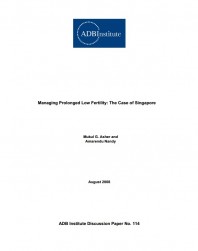
Managing Prolonged Low Fertility: The Case of Singapore

This paper analyzes Singapore’s multi-pronged approach to managing prolonged low fertility which has led to population aging, labor force shortages, increasing elderly dependency ratios, and feminization of the elderly population. This approach has emphasized high growth, and has given priority to becoming an attractive business location over providing adequate and equitable retirement and health financing; and has pursued policies designed to generate high levels of net immigration. The chosen policy priorities have created a dilemma centering on ensuring Singapore’s business competitiveness on the one hand, and meeting its residents’ needs and expectations on the other. In spite of many measures to boost fertility levels (official Total Fertility Rate was 1.29 in 2007, a rate at which population is reduced by 50% in 45 years), as well as high net immigration, population aging is expected to accelerate after 2010. This, along with high income inequalities (Gini coefficient was 0.52 in 2005), will make continuation of current policy priorities even more challenging for the policymakers. While future policy developments are difficult to predict, greater political contestability is likely to hasten the path toward policy priorities which give greater weight to the needs and expectations of the current Singapore residents, even if that leads to lower (but more sustainable and socially cohesive) growth.
- Issues:
- Health, Demography, Urbanization and Migration
- Region:
- Asia
- Country:
- Singapore
- Year Published:
- 2008
- Authors:
- Mukul G. Asher, Amarendu Nandy
- Institution:
- Asian Development Bank Institute (ADBInstitute)

